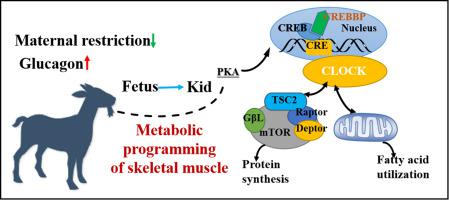Animal Nutrition ( IF 6.1 ) Pub Date : 2021-10-06 , DOI: 10.1016/j.aninu.2021.09.006 Xiaoling Zhou 1, 2, 3 , Qiongxian Yan 1, 4 , Hong Yang 1 , Ao Ren 1 , Zhixiong He 1 , Zhiliang Tan 1

|
The biological mechanism by which maternal undernutrition increases the metabolic disorder risk of skeletal muscles in offspring is not fully understood. We hypothesize that maternal intake restriction influences metabolic signals in the skeletal muscles of offspring via a glucagon-mediated pathway. Twenty-four pregnant goats were assigned to the control group (100% of the nutrients requirement, n = 12) and restricted group (60% of the control feed allowance from pregnant days 45 to 100, n = 12). Blood and Longissimus thoracis muscle were sampled from dams (100 d of gestation), fetuses (100 d of gestation), and kids (90 d after birth) in each group. The data were analyzed using the linear MIXED model, with the multiple comparison method of SIDAK applied. Intake restriction reduced (P < 0.05) the total blood protein of dams and fetuses. Maternal restriction decreased (P < 0.05) the cAMP-responsive element-binding protein 1 (CREB1), CREB-binding protein (CREBBP), protein kinase A (PKA), aryl hydrocarbon receptor nuclear translocator-like protein 1 (BMAL1), protein kinase B (AKT1), mammalian target of rapamycin (mTOR), and regulatory-associated protein of mTOR (RPTOR) mRNA expression in the fetuses, and reduced (P < 0.05) the CREBBP, nuclear receptor subfamily 1 group H member 3 (NR1H3), D-box binding PAR bZIP transcription factor (DBP) and PKA mRNA levels in the kids, but increased (P < 0.05) the peroxisome proliferator-activated receptor gamma coactivator 1 alpha (PGC1A) and tuberous sclerosis 2 (TSC2) mRNA levels in the fetuses. The mRNA expression of clock circadian regulator (CLOCK) and TSC2 genes was increased (P < 0.05) in the restricted kids. The protein expression of total PKA and phosphorylated PKA in the restricted fetuses and kids were downregulated (P < 0.05), and the protein expression of total mTOR and phosphorylated mTOR were reduced (P < 0.05) in the restricted fetuses and kids. Maternal intake restriction regulated fat oxidation, protein synthesis, and circadian clock expression in the muscles of the offspring probably via the glucagon-mediated PKA-CREB pathway, which reveals a noteworthy molecular pathway that maternal undernutrition leads to metabolic adaptation of skeletal muscle in offspring.
中文翻译:

母体摄入限制可能通过蛋白激酶 A-cAMP 响应元件结合蛋白途径对山羊后代骨骼肌中的能量代谢、生物钟调节剂和 mTOR 信号进行编程
母亲营养不良增加后代骨骼肌代谢紊乱风险的生物学机制尚不完全清楚。我们假设母亲的摄入限制通过胰高血糖素介导的途径影响后代骨骼肌的代谢信号。将 24 只怀孕山羊分配到对照组(100% 的营养需求量,n = 12)和限制组(怀孕 45 至 100 天的对照饲料供给量的 60%,n = 12)。每组均从母鼠(妊娠100天)、胎儿(妊娠100天)和幼崽(出生后90天)采集血液和胸长肌样本。采用线性MIXED模型对数据进行分析,并应用SIDAK多重比较方法。摄入限制降低了 母鼠和胎儿的血液总蛋白( P <0.05)。母体限制降低了 cAMP 反应元件结合蛋白 1 ( CREB1 )、CREB 结合蛋白 ( CREBBP ) 、蛋白激酶 A ( PKA ) 、芳烃受体核转位样蛋白 1 ( BMAL1 ) 、蛋白激酶 B ( AKT1 )、哺乳动物雷帕霉素靶蛋白 ( mTOR ) 和 mTOR 调节相关蛋白 ( RPTOR ) mRNA 在胎儿中的表达,并降低 ( P < 0.05) CREBBP、核受体亚家族 1 H 组成员 3 ( NR1H3))、 D-box 结合 PAR bZIP 转录因子 ( DBP ) 和PKA mRNA 水平在儿童中增加,但过氧化物酶体增殖物激活受体 γ 共激活因子 1 α ( PGC1 A ) 和结节性硬化症 2 ( TSC2 ) mRNA增加 ( P < 0.05 )胎儿体内的水平。 限制儿童中生物钟调节因子(CLOCK)和TSC2基因的mRNA表达增加(P <0.05)。限制胎儿和儿童总 PKA 和磷酸化 PKA 蛋白表达下调(P < 0.05),总 mTOR 和磷酸化 mTOR 蛋白表达降低(P < 0.05) 在受限的胎儿和儿童中。母体摄入限制可能通过胰高血糖素介导的PKA-CREB途径调节后代肌肉中的脂肪氧化、蛋白质合成和生物钟表达,这揭示了母体营养不良导致后代骨骼肌代谢适应的一个值得注意的分子途径。











































 京公网安备 11010802027423号
京公网安备 11010802027423号